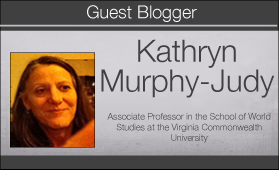Investigating the State of Online Language Learning in the US
 By Kathryn Murphy-Judy, PhD. Associate Professor in the School of World Studies, Virginia Commonwealth University.
By Kathryn Murphy-Judy, PhD. Associate Professor in the School of World Studies, Virginia Commonwealth University.
DOI: https://www.doi.org/10.69732/ZGCG6758
WHAT WE DON’T KNOW ABOUT THE CURRENT STATE OF ONLINE LANGUAGE EDUCATION IN THE US IS, WELL, PRETTY MUCH EVERYTHING:
- numbers of courses and programs;
- types of institutions and entities offering online language courses and programs;
- mechanisms for designing and developing courses;
- training and expectations of instructional designers and online faculty;
- curriculum standards and pedagogical goals and objectives;
- types of materials being used;
- course delivery and communication modalities and platforms;
- student orientation, guidance and assessment protocols;
- factors in success and failure for students and programs;
What we suspect is that it follows the national meteoric growth in online education as tracked through the annual Babson Reports (formerly known as the Sloan Report) by Allen and Seaman for post-secondary and Picciano and Seaman for K-12. The Evergreen group has also published on K-12 online and blended in Keeping Pace. Yet, we just don’t know because we have no instrument for current, thus longitudinal data collection. The Comprehensive Survey of U.S. Foreign Language Enrollments: K-12 and Higher Education called for by IIE and spearheaded through The Language Flagship has yet to see light of day and the MLA Survey (most recent 2009) does not include online language learning.

The caveat that the Babson numbers (7.1 million students taking at least one online course in a post-secondary setting in 2012) may significantly exceed those of the nces.ed.gov IPEDS report (viz., a ‘scant’’ 5.5 million) notwithstanding, the numbers speak loudly. Moreover, the constant upward trend in growth rates is not in question, far from it. The problem for world languages is that we have no ‘big data’ by means of which to count and recount our story. True, there have been two surveys canvassing aspects of online language education in the past four years. The first under the auspices of CARLA was led by Marlene Johnshoy has provided excellent information on teacher preparation for online teaching. It was followed by the Foreign Language Resource Center survey in 2012 to determine “the characteristics of successful online language learning programs.” Both of these surveys included secondary and post-secondary online respondents and both provided important information for the scope of their instruments.
A group of online practitioners, however, has recognized this serious lack of comprehensive data and has set itself to redress it, starting with post-secondary education. The Basic Online Language Design and Delivery (BOLDD) Collaboratory emerged in 2011 between the CALICO and ACTFL conferences. The fledgling group agreed to address design and delivery issues in online language education, primarily for basic (novice-intermediate low), formal language instruction. It targets predominantly where the largest numbers, fastest growth, and greatest need exist. Open to practitioners in design, development, teaching and administering, as well as those new the field, the BOLDD collaboratory and its wiki (https://sites.google.com/site/bolddcollaboratory/) are open access, welcoming anyone interested in the field. In addition to meeting at various language conferences (CALICO, ACTFL, IALLT, SCOLT, NECTFL, etc.), we also train newcomers through workshops and our evolving online guide to online language teaching and learning. Yet, in order to comprehend the field and its growth, our major push this latter half of 2014 has been to gather data on who we are, where we are, what we are doing, and how we are doing it.
 We now have crafted the first version of a national survey to gather information on the 2013-2014 academic year, post-secondary online offerings.
We now have crafted the first version of a national survey to gather information on the 2013-2014 academic year, post-secondary online offerings.
The survey has five major sections:
(1) Basic institutional information;
(2) A matrix of courses with drill down information on enrollments and student success;
(3) Design and development of courses and materials choices;
(4) Teaching modes, practices and training;
(5) Student preparation, assessment, and reasons for success.
The only required fields out of the entire 148 items are the institutional ones and the top level matrix (specific languages with courses offered online). Getting baseline data for courses and languages offered is the first and most important step in the data collection. It was distributed in early September, 2014. For initial reporting and analysis purposes, it will have closed at the end of October (although data may still be entered until the 2014-2015 instrument gets deployed in June, 2015). The BOLDD membership, the CARLA survey list, names from conferees presenting on online education at CALICO and ACTFL over the past four years were contacted and asked both to fill out the survey and to send it to other colleagues offering online courses. The invitation list contains over 400 names; I have no idea how far afield the secondary invitations have gone, but remain optimistic that social media connectivity will eventually promote wider distribution. To date, there are 125 responses from over 70 institutions. I will report on its preliminary findings at ACTFL on 11/22/14.
This first survey is limited mainly to post-secondary institutions in the USA. For the future, it is designed eventually to gather longitudinal data. I expect that its scope will expand to secondary education nationally within the next two years. We will eventually want to connect our data beyond national boundaries, especially given that online language learning is a global, borderless enterprise. Already there exists contact among worldwide designers, developers and faculty as seen at CALICO, IALLT, and FLEAT.
If you’d like to participate either in BOLDD or in the survey (albeit not for this year’s analysis), don’t hesitate to click the links above. And, if you have any comments or questions, don’t hesitate to comment here, chat with a BOLDD collaborator at national and regional events, or email me : kmurphy@vcu.edu.

